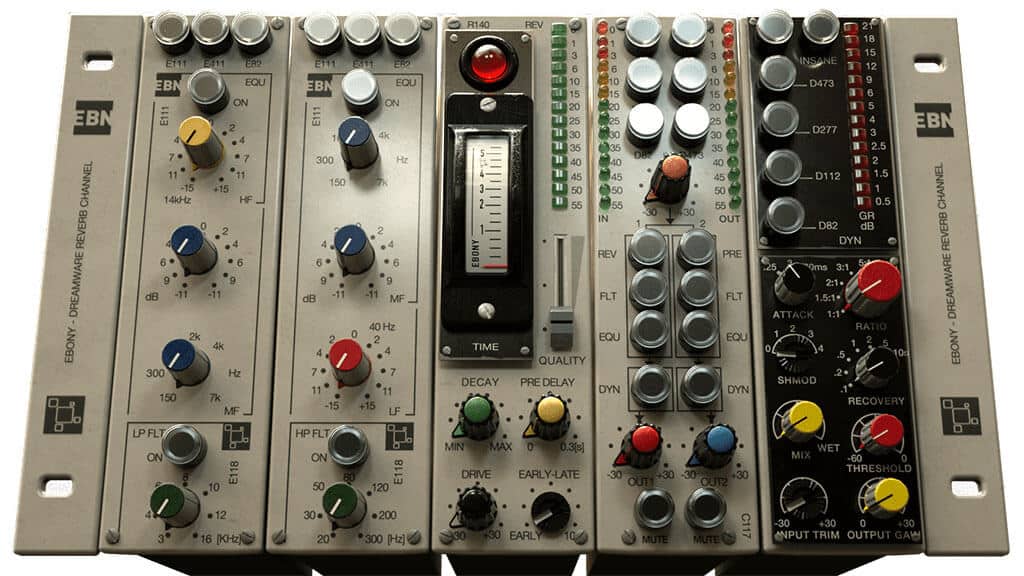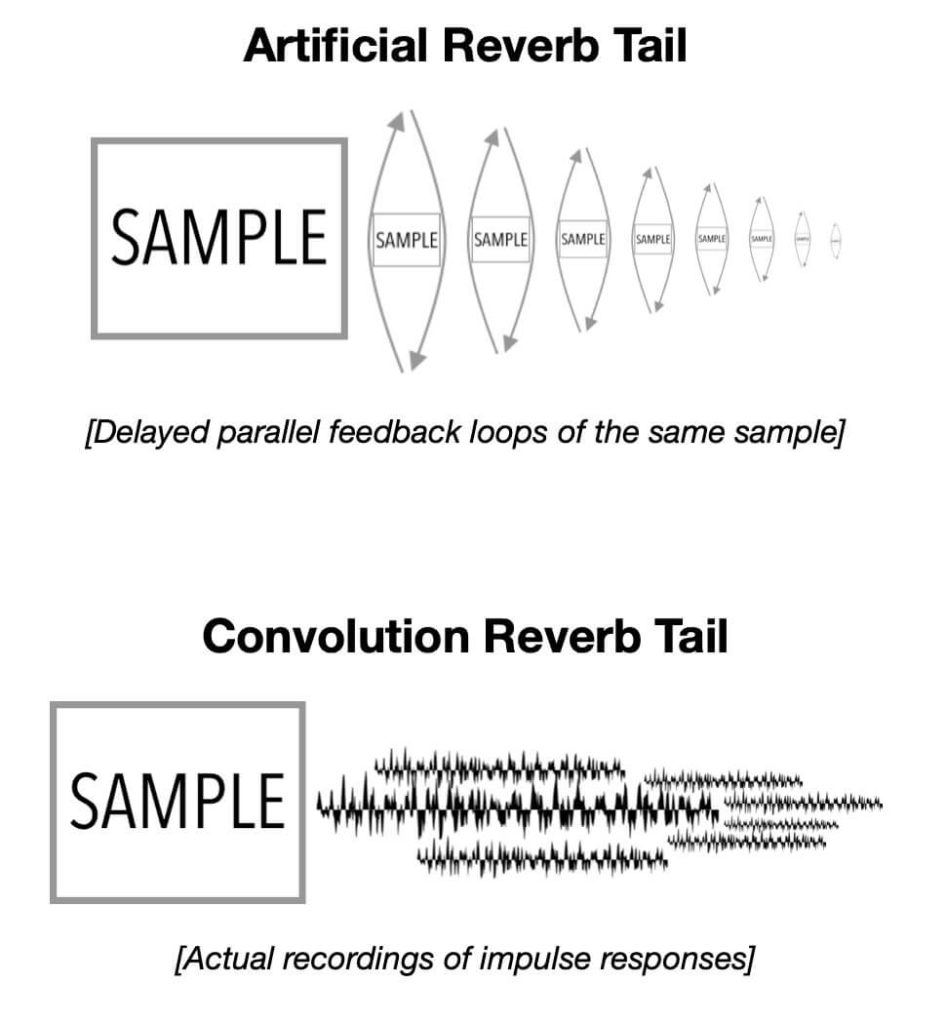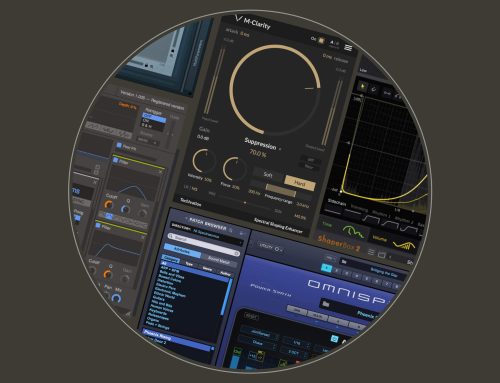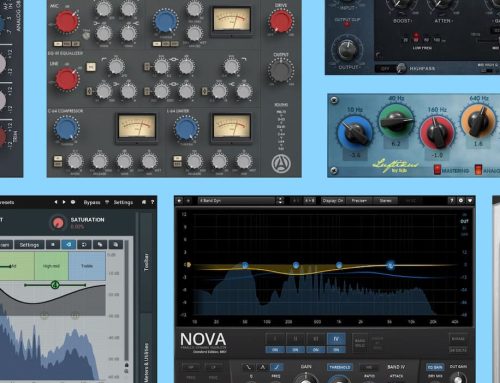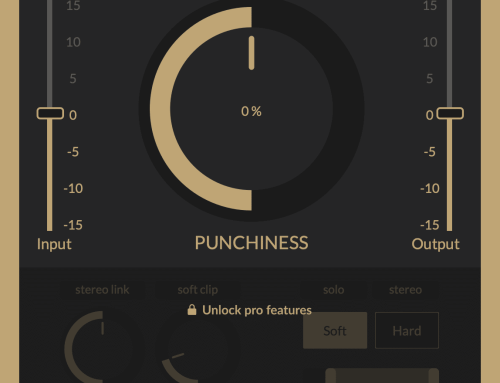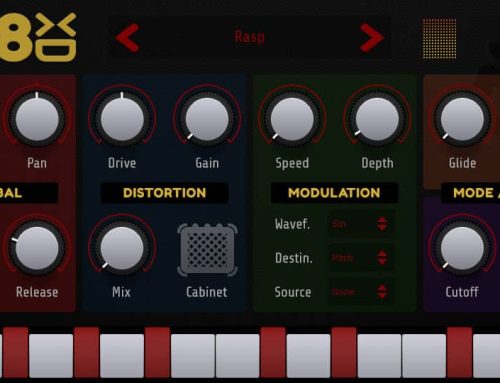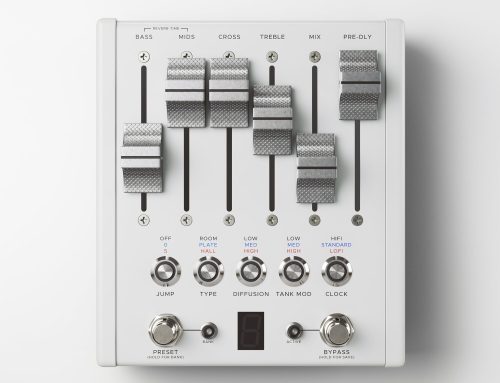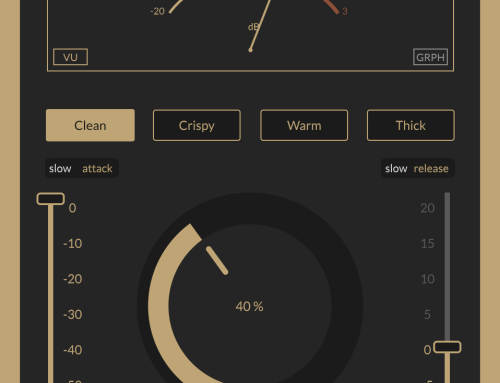The reverb plugin I want to talk about today is a plugin emulation of the legendary EMT140 plate. It comes in the Ebony Channel strip from Acustica Audio. If you’re getting confused by the alien-looking picture above, the reverb is the 3rd unit, right in the middle of the channel strip. This is by no means, a review of the whole Ebony, but rather just the reverb. Every single one of those 5 processors above is incredibly complex and I can’t synthesize even the highlights in one article.
Let’s talk about reverb choices
Up until recently, I’ve always been thinking of reverbs in two different categories: Acoustic and Mechanical. The acoustic ones generate reverberation similar to the one in acoustic spaces like halls, churches and other types of rooms. Mechanical reverbs on the other hand use either a spring or a plate to resonate and recreate acoustic-like sensation.
In my opinion, they have a lot more color and character. Though, each has its own place and uses. For example springs generally sound good on guitars, because most people are used to hearing the guitar through amps. Most guitar amp manufacturers use them as a go-to choice, because of their convenience in cost and size.
Plate Reverbs
Plate Reverbs are my favorite choice for vocals. Here’s the simplest way to explain plates for those who are unfamiliar with the mechanism. Imagine a gigantic speaker in which the cone is made of a flat metallic plate instead of paper. The coil of the speaker (magnet) is attached directly to the metal plate. Its resonance is what the reverb sounds like.
The EMT140 Reverb
EMT140 was the first-ever made plate reverb and is considered to be the holy grail of plates. It’s due to its unique sound and character. That’s why the majority of plugin plates today are based on it one way or another.
When we talk about reverb plugins the fact is that the choice of reverbs is huge and many of them are good. You don’t even have to break the bank and the proof is all the engineers who use only stock plugins and still make hit records. For example, Barny Barnicott (Arctic Monkeys, Coldplay, The1975). He uses only the D-Verb that comes with Pro Tools.
I myself am one to have spent a considerable amount of money on reverbs. Until now I was very proud of using high-end emulations by Universal Audio, Valhalla, Soundtoys and Waves. That is until I was introduced the EMT140 plate by Acustica Audio. I was forced to rethink everything I know about plugin reverbs.
Artificial vs Convolution
Most reverb plugins are artificial (using a specific algorithm to digitally generate reverb). EMT140 emulation that Ebony offers is based on convolution. To make it easier for those who are unfamiliar with how both types process sound: artificial reverbs are generated by complex models of delaying samples. They create feedback loops and gradually lower their level to create the reverb tail.
Convolution reverbs, on the other hand, attach to your samples actual recordings of real reverbs generated by recording impulse responses (IR) in different spaces. To hide the trigger sample they use cancellation by phase inversion. So you’re left with the pure reverb recording ready to attach to your own samples. That makes convolution reverbs much more natural and organic-sounding, but they have a huge drawback.
Convolution Drawbacks
As you can probably imagine generating reverbs by playing back hundreds of actual reverb recordings can be incredibly energy deficient. Ebony is a pure example of that. While the reverb is one of a kind and probably one of the best reverb plugins I have ever tried – using it can be challenging. Very few CPUs can handle the pressure of scanning through hundreds of IR recordings and playing them back with no latency. For larger mixes that means committing and printing as even the latest 6-core i5 Intel CPU can barely handle it.
The Sample Rate
That also means forgetting about lower sample rates. Unless of course, you’re working on a super-computer capable of hacking NASA. On the other hand, the plugin isn’t too friendly to higher sample rates either so you have to find the sweet spot. In my experience setting the buffer size at 256 samples works just fine. Now, I know that might scare most people away, but trust me when I say this – it’s worth it. As long as I can use that reverb on my mixes I’m happy to make the scarifies.
Editing Limitations
Another drawback is that most convolution-based plugins are unable to edit the parameters of the reverbs by a great degree. For example, if the recorded IR has a tail of 2 seconds, you won’t have the flexibility to adjust the decay time. The Ebony, however, offers control over not only the length of the reverb but its character, intensity and much more. As expected there’s a price to be paid for this flexibility and it’s contributing to the CPU related drawback I mentioned above.
Reliability
The third and last drawback I can think of is reliability. That has nothing to do with CPU usage. I’m talking about your trust in the developers of the plugin. When you use artificial reverbs you pretty much have to rely on software and its algorithm. However, when convolution is involved you have to trust the recording process of the impulse responses in addition to the software and its algorithm. Straight away we are now talking about microphones, placement, amps, converters, engineers, room temperature and how sober the engineers and developers were during the process. All jokes aside, if it sounds good – it sounds good and that’s all that matters. I personally believe the guys at Acustica Audio can be trusted as they seem to aim for precision and perfection.
Ebony Reverb Plugin in Action
The best way to describe the experience of sitting in the sweet spot of my Adams while the Ebony is in action is by trying to visualize the sound. Imagine two surfaces in-front of you. The first surface is flat as a pancake, while the second looks like a skyline diffuser with variable depth.
Depth of The Reverb
Artificial reverbs give me the impression that the sound coming through the speakers is flat and I’m not talking in frequency response here. I literally mean flat like a 2-dimensional picture – I can hear width, but not much depth. The Ebony plate, however, creates the sensation of a 3- dimensional sound coming out of the speakers. I feel like I can not only detect the width, but also the depth of the reverb. I’ve spoken many times before about 3D sounding plugins and depth, but now after using the Ebony I need to rethink those whole concepts altogether.
The 3D sensation of the plate comes from a rather strange pulsing I can feel back and forth projected on me from the speakers. It literally feels like the whole track is pulsating and I can’t think of a better word. Michael Brauer’s technique of spreading your whole mix to 4 different busses and 4 different unlinked compressors creates a similar pulsing sensation although it’s more of a stereo pulse, while the Ebony is pulsating in depth.
For more information about mixing in-depth read Creating an in-depth mix
Another Strange Phenomenon
Another strange phenomenon about the Ebony is that the reverb is responding differently to every single sample. The different levels of samples being sent to the verb make the plate respond completely different in character, intensity, and even tonality. This is quite hard to describe and the only way to understand what I’m talking about is to try it out for yourself and then revert back to an artificial reverb emulation.
The controls of the plugin also behave rather strange. Aside from the fact that sometimes I have to press a button several times to activate a function as the CPU is getting fried in an inferno of processing, the way the different parameters affect the response of the plugin is quite dramatic.
Plugin Controls’ Behavior
The most dramatic of them all is the INPUT parameter. In theory, a slight bump on that little knob should increase the level going in the plate and alter the reverb, but in practice, a minor bump on the INPUT feels like what I would imagine a half-asleep horse experiences when being injected with a pure adrenaline shot. It amplifies the sensation of changes in character, intensity, and tonality by fold. It is an incredibly sensitive control that should be handled carefully. If I could make a suggestion to Acustica Audio it would be to rename the INPUT to NUKE.
The DRIVE knob warms up the sound, while the PRE DELAY does exactly as suggested. At first, I thought the EARLY-LATE control serves as a form of DRY/WET control, while the DECAY controls the length of the tail, but I’m not sure that’s the case. Since I can’t put it into words the only thing I’ll say it that the DECAY, EARLY-TIME, and QUALITY controls behave incredibly strange. The different combinations of their parameters affect each other dramatically and can create incredible effects. Each of them can change the tonality and character of the reverb and the only way to understand it is to experience it yourself.
Sample Testing
Below I have included several samples of the reverb with screenshots of the reverb plugin’s parameters to try and give you a glimpse of what this monster can do. The dry drum sample is courtesy of “That Sound” and comes with their “Neon” package. The first example shows the default parameters of the plugin, while the second shows what happens from a slight alteration.


Does this reverb plugin sound like a real plate?
After spending some more time with the plugin I realized that all those strange responses I’m getting like the difference in intensity and sound character produced by the variable input gain, as well as the variable gains of each sample within the reverberated track, are not strange at all. This is how a real plate should respond in theory. Imagine you had a giant gong in-front of you. The difference in the velocity between gently tapping it and whacking it forcefully will completely change the response of the resonance both in tone, character, intensity and decay time and that is exactly what is happening in the Ebony plate. I know in theory all plate and spring plugins should exhibit that behavior, but trust me when I say this – they don’t.
Now, does the Ebony sound like a plate? I suppose the answer is both yes and no. Yes – because the response theoretically should be correct as suggested by my “giant gong” theory. No – because real analog plates are dirty and gritty-sounding. In fact, a real somewhat preserved EMT140 plate can be very nasty and unclean, while the Ebony plugin provides a much more defined sound.
Price
That beast of a plugin comes at $199. I can see how that might be expensive for some people, but I don’t think it’s that scary. After all, we are talking about a plugin that could make it very difficult to spot the difference between a real EMI140 plate and its own performance. Let’s put it this way – I would be happy to pay the $199 just for the reverb alone. But if we take into account the preamps, EQs and Compressors the Ebony comes with, the deal becomes a no-brainer. The closest competitors to Acustica’s Ebony would be Universal Audio. Though they would easily charge you $1,000 for all those processors.
Conclusion
If $199 isn’t a dealbreaker for a reverb plugin, I’d say the Ebony is the closest thing you’ll get to an EMT140 plate. The software has its own drawbacks as it requires tremendous processing power. But, in my opinion, it is worth the hassle of committing and printing. Judging by the incredible accuracy in the modeling of that plate. I am very excited to try out the rest of what Acustica Audio has to offer. I’ve always been a Universal Audio user and I still believe they make the best emulations of vintage gear. That being said, now that I’ve used the Ebony I’m starting to think there could be a level above UA.
Acustica Audio is a prime example of a company that’s way ahead of its time. Maybe in another 5-10 years, I’ll be able to load huge mixes full of their plugins. For that to happen though, we’ll need some serious advancements in commercial computing power.

Written By Ivo Sotirov

